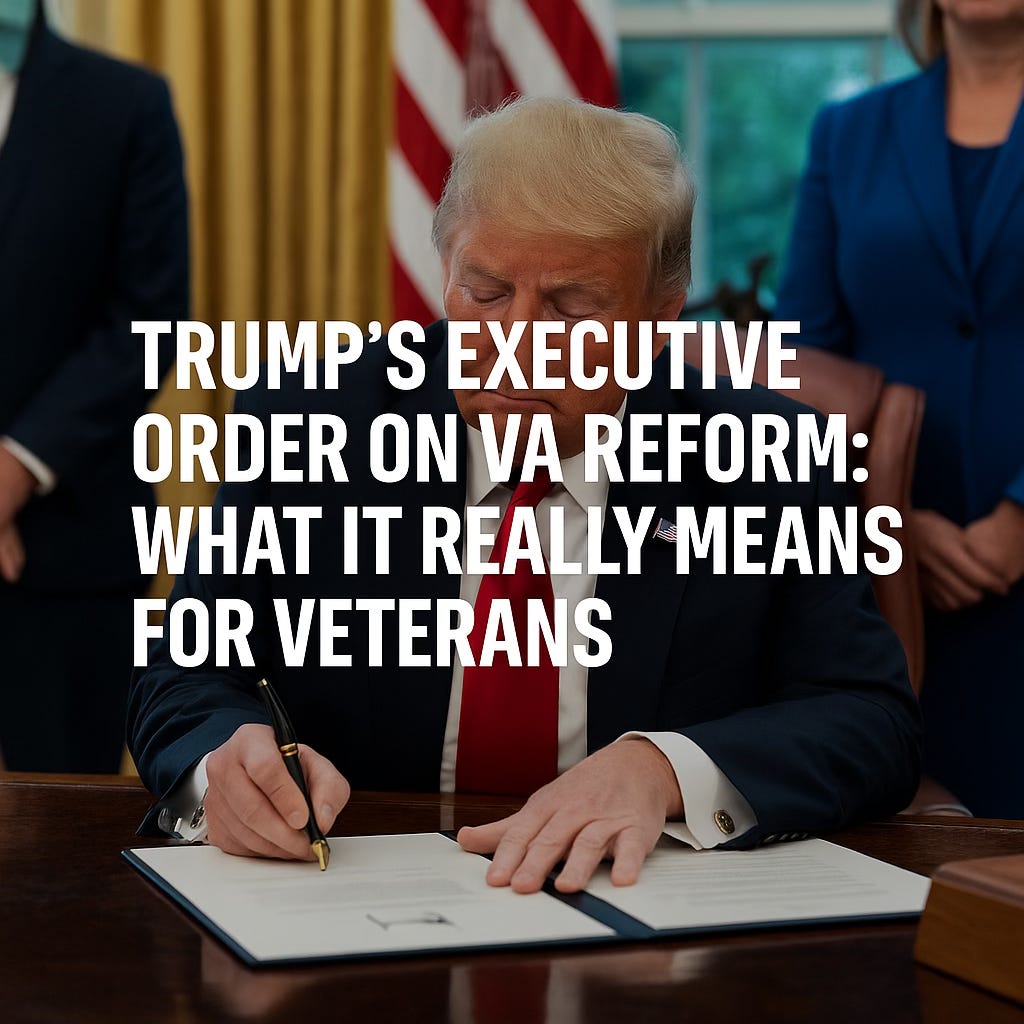✍️ Trump’s Executive Order on VA Reform: What It Really Means for Veterans
It’s Big But Not Beautiful
Trump’s Executive Order on VA Reform: What It Really Means for Veterans
Another press release or real change? We break down what’s promised—and what’s missing.
On the surface, President Trump’s new executive order looks like a win for veterans—better healthcare, new facilities, and stronger support for unhoused vets.
But let’s take a closer look at what’s really going on, what’s being promised, and—most importantly—what’s missing.
🏥 New Veteran Service Facilities: Hope on Both Coasts
The order includes plans for two new or revitalized VA facilities:
West Los Angeles VA Campus
This site has a long, messy legal history. It was supposed to serve unhoused veterans, but much of the land was leased out for non-veteran use. Now, under this order, it’s being reimagined to house up to 6,000 veterans by 2028, offering shelter, addiction treatment, and other wraparound services. That’s a big promise—but one that veterans in L.A. have heard before.
Manchester VA Medical Center, New Hampshire
The only state without a full-service VA hospital may finally get one. Trump’s order calls for a fast-track plan to expand services, aiming for a full facility by early November. That’s a huge deal for veterans in rural New England who’ve had to travel hours for basic care.
🕓 As of June 2025, no federal funding has been allocated to begin construction at the Manchester site.
⏳ Reducing Wait Times—Again
This part of the order feels familiar. The goal is to reduce long wait times by:
Extending clinic hours
Offering weekend appointments
Expanding Community Care options
Veterans already have the legal right to community care under the VA MISSION Act of 2018. But red tape, staffing shortages, and a system that doesn’t tell us our rights still keep many of us stuck.
⚖️ Holding the VA Accountable—But to Whom?
The executive order leans on the VA Accountability and Whistleblower Protection Act of 2017, a law designed to remove bad actors from the VA system.
That’s good on paper. But accountability should go both ways. Veterans also need protection from rushed decisions, unfair denials, and staff who treat us like numbers instead of people.
One recent example: the VA's own SMC calculator was underpaying veterans for years—an error they quietly confirmed. Read more here.
Will this order help fix that? We’ll see.
🏘️ A Bigger Push for Homeless Veteran Housing
This one could be huge—if it’s fully funded.
The order calls for tighter coordination between the VA and HUD to get more veterans housed, mainly through the HUD-VASH program, which provides Section 8-style vouchers with VA case management.
The plan? Expand the number of vouchers and bring more veterans off the streets and into stable housing.
It’s a critical step—but not a new one. The infrastructure for this already exists. What we need now is the political will (and money) to scale it.
💰 Where’s the Money Coming From?
Here’s the fine print. The administration has floated a 4% increase in discretionary VA funding for FY2026.
That sounds helpful—but it may not even scratch the surface when it comes to:
Building new hospitals
Hiring more staff
Expanding mental health and substance abuse services
Without real funding, these promises risk becoming more of the same.
⚠️ VA Reform Through the Years: Why Veterans Are Skeptical
When presidents talk about “fixing the VA,” they often act like they’re the first to try. But veterans know better. We've been through reform cycles with every administration—each with its promises, pitfalls, and predictable fadeouts.
It’s not about who’s in charge—it’s about who actually follows through.
Here’s how the pattern has played out:
Ronald Reagan (1981–1989)
What Worked: Supported elevating the VA to Cabinet-level status
What Failed: Froze VA hiring and imposed austerity
What Faded: Talk of privatization never materialized
George H. W. Bush (1989–1993)
What Worked: Created the Department of Veterans Affairs
What Failed: Minimal reform during the Gulf War
What Faded: “Earned benefit” rhetoric lacked follow-through
Bill Clinton (1993–2001)
What Worked: Expanded eligibility through the 1996 Health Care Eligibility Reform Act
What Failed: VA infrastructure couldn’t keep up
What Faded: Digital modernization slowed
George W. Bush (2001–2009)
What Worked: Increased VA funding post-9/11
What Failed: Scandals at Walter Reed
What Faded: Wartime urgency muted reform momentum
Barack Obama (2009–2017)
What Worked: Addressed veteran homelessness; expanded mental health access
What Failed: Wait-time scandal and unmet housing goals
What Faded: Accountability promises stalled in bureaucracy
Donald Trump (2017–2021)
What Worked: Passed the VA MISSION Act; created Accountability Office
What Failed: Confusing MISSION Act rollout
What Faded: Reform messaging blurred into privatization fears
Joe Biden (2021–2025)
What Worked: Passed the PACT Act; increased funding
What Failed: Implementation delays; backlogs persisted
What Faded: Reversing privatization remained inconsistent
Donald Trump (2025–Present)
What Worked: TBD
What Failed: TBD
What Faded: TBD
🧭 The Pattern Is Clear
Every president starts with a promise—and ends in partial delivery, if not outright stagnation. It’s why so many veterans read “VA reform” as code for “wait and see.”
Oversight matters. Funding matters. Veteran voices matter.
🔍 Bottom Line: Hope, But Watch the Details
This executive order sends the right signals. It acknowledges the pain points: long wait times, inadequate facilities, and homeless veterans being left behind.
But like most things involving the VA, the real question is: Will it actually happen?
Veterans deserve more than photo ops and press releases. We need action. Oversight. Follow-through. We need people in power who treat this like a moral obligation—not a headline.
So if you’re a veteran—or you love one—keep your eye on this. Ask questions. Demand transparency. And don’t be afraid to push back if promises go unmet.
Because if there’s one thing we’ve learned in this quiet fight, it’s this:
No one advocates harder for veterans than veterans themselves.
💬 Feel this too?
Share this post. Drop a comment. That’s what Tbird’s Quiet Fight is about—telling the truth out loud, together.



